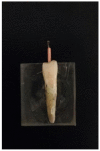Comparison of Two Root Canal Filling Techniques: Obturation with Guttacore Carrier Based System and Obturation with Guttaflow2 Fluid Gutta-Percha
- PMID: 35448065
- PMCID: PMC9032128
- DOI: 10.3390/dj10040071
Comparison of Two Root Canal Filling Techniques: Obturation with Guttacore Carrier Based System and Obturation with Guttaflow2 Fluid Gutta-Percha
Abstract
Introduction: The aim of the present study was to compare the quality of the root canal obturation obtained with two different techniques, i.e., thermoplastic gutta-percha introduced through a carrier (GuttaCore) and fluid gutta-percha (GuttaFlow2).
Materials and methods: The study included 40 permanent single-rooted human teeth, divided into two groups and obturated with Guttaflow (group G) and with GuttaCore (group T). The teeth were fixed and transversely sectioned, they were examined by scanning electron microscopy. The dentin-cement-gutta-percha interface and the percentage of voids produced by the two techniques were statistically analyzed.
Results: GuttaCore showed a better filling in the apical third of the canal with a percentage of voids equal to 5%. GuttaFlow showed a lower percentage of voids in the middle and coronal thirds of the canal, 1.6% of coronal voids. Statistical analysis showed a statistically significant difference in the percentage of voids in the two groups (GuttaCore and Guttaflow2) in each portion.
Conclusions: GuttaFlow2 seems to flow optimally in the middle and coronal third of the canal, with greater difficulty in filling the apical third. Due to the rigidity of the carrier, GuttaCore is able to reach better the most apical portions of the canals, with greater difficulty in creating the three-dimensional seal at the level of the middle third and coronal third.
Keywords: GuttaCore; GuttaFlow; marginal gaps; microleakage; three-dimensional seal.
Conflict of interest statement
The authors declare no conflict of interest.
Figures











References
-
- Junior J.F.S., Rôças I.d.N., Marceliano-Alves M.F., Pérez A.R., Ricucci D. Unprepared root canal surface areas: Causes, clinical implications, and therapeutic strategies. Braz. Oral. Res. 2018;32((Suppl. S1)):e65. - PubMed
-
- Greco K., Cantatore G. A critical approach to the root canal obturation techniques. Giornale Ital. Di Endod. 2014;28:48–78. doi: 10.1016/j.gien.2014.09.002. - DOI
LinkOut - more resources
Full Text Sources

